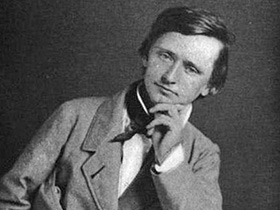You are here

3/12/1822 - 5/11/1872
Poet and sculptor (and Corner Ketch native) Thomas Buchanan Read first achieved prominence with his celebratory poem, Sheridan's Ride.
Born in Corner Ketch, Pennsylvania, in 1822, Thomas Buchanan Read both painted and wrote about a fervently patriotic and idealistic subject matter. Befriending famed poet Henry Wadsworth Longfellow and spending a great deal of his adult life in Italy, Read was a major figure in mid-nineteenth century literary and artistic culture. He produced some of the most recognizable Civil War images and verse in multiple renditions of his Sheridan's Ride (1871) and lyrically captured the aesthetic quality of Pennsylvania's geography in "The New Pastoral" (1855). He died in 1872 in New York City.
Thomas Buchanan Read, the revered 19th century poet and artist whose work forever captured the patriotic fever of his day, was born on March 12, 1822, in Corner Ketch, Pennsylvania. Receiving only an elementary education, the sudden death of his father led to an abusive, cruel, and short-lived apprenticeship to a local tailor. By age 15, Read had worked in Philadelphia under a grocer and tobacconist, and was residing in Cincinnati with his sister. There, he painted signs and learned the art of sculpture as an apprentice to Shobal Veil Clevenger. Throughout his teen years, Read never received a formal education, as a lack of money and natural ability in the fine arts rendered the idea of schooling impossible and fruitless.
As a young adult in Cincinnati, Read set up his own studio with the help of horticulturalist, millionaire, and patron Nicholas Longworth, gaining national recognition in 1840 for his portrait of Whig presidential candidate William Henry Harrison and publishing his first collection of poetry in the Cincinnati Chronicle and Times. In 1841, Read moved to Boston and befriended famed poet Henry Wadsworth Longfellow and painter Washington Allston. The young artist was greatly influenced and encouraged by these two artists' patriotic style and thematic content, as seen in his first and only novel Paul Redding, A Tale of the Brandywine (1845), a melodrama set on Chester County's Brandywine river, published during this time of "enlightenment." Also, in 1843, Read married an Ohio woman, Mary J. Pratt, with whom he had three children.
Throughout the late 1840s and 1850s, spending the bulk of his time in Italy, Read established himself as one of the world's leading artistic and literary voices. In fact, the great number of commissions he received prompted him to write to patron and friend James Claghorn that "success has at length [had] begun to dawn upon [him]." "A New Pastoral," one of Read's more notable works, was completed in Florence in 1854. In this series of 37 textual illuminations, Read offers a romantic vision of Pennsylvania's countryside, writing that "no lovelier landscape meets the traveller's eye." He couples his lyrical blank verse with a story of a family's journey from middle Pennsylvania to the Mississippi river. "I am at least conscious of having had a religious desire to do a great and good work," Read wrote about the piece to Claghorn, "—something worthy of my country, a national poem which the world will not willingly let die." Unfortunately, the death of his wife and two of his children from cholera in 1855 undermined the rest of Read's time in Italy.
With the outbreak of the Civil War in 1861, Read moved back to the United States and enlisted in the Union army. The literary work of his tenure as a soldier, The Wagoner of the Alleghenies (1862), "The Oath," (1864) and "The Defenders" (1865) were popular readings among Northern lecturers, as their pro-Union sentiments and unwavering sense of patriotism inspired the masses. As an exemplary piece of Read's contemporary literary focus, "The Defenders" details the spirit of the Union symbolically through a description of the bald eagle. "True to its native sky, / Still shall our eagle fly," reads the verse, "Casting his sentinel glances afar, / Though bearing the olive branch / Still in his talons staunch, / Grasping the bolts of the thunders of War!"
"Sheridan's Ride" (1865), Read's most famous work, was also published during his time of service to the government. A lyrical embodiment of General Phillip Henry Sheridan's October 19, 1864, ride to rally Union troops at the battle of Cedar Creek, the poem's patriotic theme and the general's heroism encouraged audiences throughout the North. "The affrighted air with a shudder bore," Read writes, "...Telling the battle was on once more, And Sheridan twenty miles away." When the war ended, the Union League of Philadelphia commissioned Read to bring his textual design to life in a painting. This life-sized image depicts a stout General Sheridan courageously pushing forward towards Cedar Creek atop his horse, Rienzi, a galloping black stallion. Read also sculpted busts of the General.
Having remarried, Read moved back to Italy in 1867 with his new wife, Harriet Dennison. "Always of a genial temperament," as the New York Times describes the artist in his obituary, Read found favor among the Roman artistic and literary community, adopting a religiously idealistic subject matter. "A Painter's Dream" (1869), one of the painter's last works, exemplifies his spiritually thematic venture, as it depicts a Venus figure floating above an artist and aiding him in his muse. Unfortunately, in 1871, Read's carriage overturned, leaving him badly injured and never able to fully recover. The next year Read left for the United States, dying soon after his arrival in a New York port. His body is buried on Laurel Hill in Philadelphia.
Poetry
- The New Pastoral. Philadelphia: Parry & M'Millan, 1855.
- The Wagoner of the Alleghenies: A Poem of the Days of Seventy-Six. Philadelphia: J. B. Lippincott & Co., 1862.
- The Oath, or, Ye Freemen, How Long Will Ye Stifle. Philad[elphi]a (N.E. cor. 11th & Market): A.W. Auner, 1864.
- A Summer Story, Sheridan's Ride, and Other Poems. Philadelphia: J.B. Lippincott & Co., 1865.
- The Defenders. (Poems, etc., in Patriotism in Poetry and Prose: Being Selected Passages from Lectures and Patriotic Readings) Philadelphia, PA: J.B. Lippincott & Co., 1865.
Novels
- Paul Redding: A Tale of the Brandywine. New York: E. Ferrett & Co, 1845.
Art
- Harp of Erin. Cincinnati Art Museum, 1867.
- A Painter's Dream. Detroit Institute of Arts, 1869.
- Sheridan's Ride. National Portrait Gallery, 1871.
- Cousin, John William. "Read, Thomas Buchanan." A Short Biographical Dictionary of English Literature. London: J.M. Dent, 1910.
- Krile, Katherine M. "Read, Thomas Buchanan." American National Biography. Feb. 2000. 24 June 2007. <http://www.anb.org/articles/17/17-00715.html>.
- "Obituary: Thomas Buchanan Read." New York Times (12 May 1872): 1.
- "PHILIP H. SHERIDAN (1831-1888) by Thomas Buchanan Read (1822-1872)." A Brush with History: Paintings From the National Portrait Gallery. National Portrait Gallery. 26 June 2007. <http://www.npg.si.edu/cexh/brush/index/portraits/sheridan.htm>. Page content replaced.
- Stover, Catherine. "James L. Claghorn, Philadelphia Collector." Archives of American Art Journal 27.4 (1987): 4-8.
- "Thomas Buchanan Read." ExplorePAhistory. Pennsylvania Historical and Museum Commission. 24 June 2007. <http://www.explorepahistory.com/hmarker.php?markerId=619>. Page content replaced.
- "Thomas Read — Artist, Art, Thomas Buchanan Read." AskART. 2007. 22 June 2007. <http://www.askart.com//askart/artist.aspx?artist=25736>.
Photo Credit: "Photograph of Thomas Buchanan Read." c. 1840. Photograph. Licensed under Public Domain. Cropped to 4x3. Source: Wikimedia.
